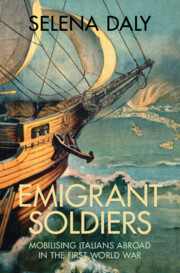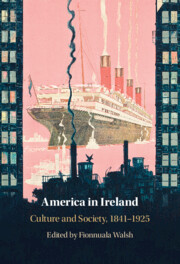Refine search
Actions for selected content:
77 results
A Little Lift in the Iron Curtain: Emigration Restrictions and Criminal Activity in Socialist East Germany
-
- Journal:
- Perspectives on Politics , First View
- Published online by Cambridge University Press:
- 25 August 2025, pp. 1-20
-
- Article
-
- You have access
- Open access
- HTML
- Export citation
Bonded citizenship: Caste, Partition, and the prevention of exit
-
- Journal:
- Modern Asian Studies , First View
- Published online by Cambridge University Press:
- 23 June 2025, pp. 1-28
-
- Article
-
- You have access
- Open access
- HTML
- Export citation

Emigrant Soldiers
- Mobilising Italians Abroad in the First World War
-
- Published online:
- 05 June 2025
- Print publication:
- 26 June 2025
8 - Shaping Russia’s Wartime Ideology (2022–2024)
-
- Book:
- The Rise of the Russian Hawks
- Published online:
- 11 June 2025
- Print publication:
- 29 May 2025, pp 251-290
-
- Chapter
- Export citation
7 - Brides
-
- Book:
- Making Do
- Published online:
- 24 April 2025
- Print publication:
- 24 April 2025, pp 242-278
-
- Chapter
- Export citation
8 - Representations of the Returned Yank in the Emigration to America Questionnaire, 1955
-
-
- Book:
- America in Ireland
- Published online:
- 09 January 2025
- Print publication:
- 23 January 2025, pp 196-219
-
- Chapter
- Export citation
Chapter 2 - From Vienna to The Hague
-
- Book:
- Otto Neurath in Britain
- Published online:
- 09 January 2025
- Print publication:
- 23 January 2025, pp 32-64
-
- Chapter
- Export citation
Chapter 4 - Becoming ‘British Furniture’
-
- Book:
- Otto Neurath in Britain
- Published online:
- 09 January 2025
- Print publication:
- 23 January 2025, pp 97-128
-
- Chapter
- Export citation
Introduction
-
-
- Book:
- America in Ireland
- Published online:
- 09 January 2025
- Print publication:
- 23 January 2025, pp 1-17
-
- Chapter
- Export citation
1 - Reflections on the Meaning of America in Irish Emigrant Material Culture, 1845–1925
-
-
- Book:
- America in Ireland
- Published online:
- 09 January 2025
- Print publication:
- 23 January 2025, pp 18-41
-
- Chapter
- Export citation
Afterword
-
-
- Book:
- America in Ireland
- Published online:
- 09 January 2025
- Print publication:
- 23 January 2025, pp 220-231
-
- Chapter
- Export citation

America in Ireland
- Culture and Society, 1841–1925
-
- Published online:
- 09 January 2025
- Print publication:
- 23 January 2025
Chapter 7 - Communist Nationalizations, Jewish Property, and Emigration
-
- Book:
- Justice and Restitution in Post-Nazi Romania
- Published online:
- 06 January 2025
- Print publication:
- 09 January 2025, pp 222-268
-
- Chapter
- Export citation
11 - What Good Can Activists Do?
-
- Book:
- Out of Poverty
- Published online:
- 02 January 2025
- Print publication:
- 09 January 2025, pp 171-195
-
- Chapter
- Export citation
4.10 - The Émigré
- from History 4 - Heroes
-
-
- Book:
- The New Cambridge History of Russian Literature
- Published online:
- 31 December 2024
- Print publication:
- 12 December 2024, pp 842-858
-
- Chapter
- Export citation
11 - Egypt
-
-
- Book:
- States and their Nationals Abroad
- Published online:
- 04 December 2024
- Print publication:
- 05 December 2024, pp 256-275
-
- Chapter
- Export citation
10 - The Abyss
- from Part IV - A Lost Homeland: 1930–2000
-
- Book:
- Germany through Jewish Eyes
- Published online:
- 14 November 2024
- Print publication:
- 21 November 2024, pp 165-182
-
- Chapter
- Export citation
Confronting the Deportation State: Black American Responses to Immigrant Expulsion in the Interwar Period
-
- Journal:
- Modern American History / Volume 7 / Issue 2 / July 2024
- Published online by Cambridge University Press:
- 06 September 2024, pp. 181-203
-
- Article
-
- You have access
- Open access
- HTML
- Export citation
4 - Becoming Refugees, 1954–1960s
-
- Book:
- Migration at the End of Empire
- Published online:
- 30 May 2024
- Print publication:
- 06 June 2024, pp 176-222
-
- Chapter
- Export citation
3 - Gender, Migration, and Sexuality in the Modern World
-
-
- Book:
- The Cambridge World History of Sexualities
- Published online:
- 26 April 2024
- Print publication:
- 16 May 2024, pp 50-70
-
- Chapter
- Export citation
